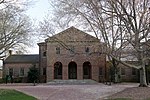Williamsburg, Virginia

Williamsburg is an independent city in Virginia, United States. As of the 2020 census, it had a population of 15,425. Located on the Virginia Peninsula, Williamsburg is in the northern part of the Hampton Roads metropolitan area. It is bordered by James City County on the west and south and York County on the east. English settlers founded Williamsburg in 1632 as Middle Plantation, a fortified settlement on high ground between the James and York rivers. The city functioned as the capital of the Colony and Commonwealth of Virginia from 1699 to 1780 and became the center of political events in Virginia leading to the American Revolution. The College of William & Mary, established in 1693, is the second-oldest institution of higher education in the United States and the only one of the nine colonial colleges in the South. Its alumni include three U.S. presidents as well as many other important figures in the nation's early history. The city's tourism-based economy is driven by Colonial Williamsburg, the city's restored Historic Area. Along with nearby Jamestown and Yorktown, Williamsburg forms part of the Historic Triangle, which annually attracts more than four million tourists. Modern Williamsburg is also a college town, inhabited in large part by William & Mary students, faculty and staff.
Excerpt from the Wikipedia article Williamsburg, Virginia (License: CC BY-SA 3.0, Authors, Images).Williamsburg, Virginia
Colonial Williamsburg's Merchants Square, Williamsburg
Geographical coordinates (GPS) Address Nearby Places Show on map
Geographical coordinates (GPS)
| Latitude | Longitude |
|---|---|
| N 37.270833333333 ° | E -76.706944444444 ° |
Address
Colonial Williamsburg's Merchants Square 414
23185 Williamsburg
Virginia, United States
Open on Google Maps









